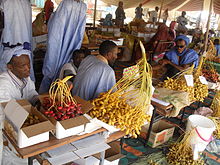Economy of Mauritania

A market place in Tidjikja
|
|
| Currency | Ouguiya |
|---|---|
| Calendar Year | |
|
Trade organisations
|
AU, African Development Bank, World Bank, IMF, WTO, Group of 77 |
| Statistics | |
| GDP |
Rank: 157 (2012 est.) |
|
GDP growth
|
|
|
GDP per capita
|
$2,200 (PPP) (2012 est.) Rank: 190 (2012 est.) |
|
GDP by sector
|
agriculture (14.9%) industry (48.0%) services (37.1%) (2012 est.) |
|
|
|
|
Population below poverty line
|
40% (2004 est.) |
| 39 (2000) | |
|
Labour force
|
1.318 million (2007) |
|
Labour force by occupation
|
agriculture (50.0%) industry (10%) services (40%) (2001 est.) |
| Unemployment | 30% (2008 est.) |
|
Main industries
|
petroleum, mining (iron ore, gold, copper, gypsum), fish processing |
| 160th (2017) | |
| External | |
| Exports |
|
|
Export goods
|
petroleum, iron ore, gold, copper, gypsum, fish |
|
Main export partners
|
|
| Imports |
|
|
Import goods
|
machinery, petroleum products, food |
|
Main import partners
|
|
|
Gross external debt
|
|
| Public finances | |
|
|
|
| Revenues | $1.143 billion (2012 est.) |
| Expenses | $1.263 billion (2012 est.) |
A majority of the population of Mauritania depends on agriculture and for a livelihood, even though most of the nomads and many subsistence farmers were forced into the cities by recurrent droughts in the 1970s and 1980s. Mauritania has extensive deposits of iron ore, which account for almost 50% of total exports. The decline in world demand for this ore, however, has led to cutbacks in production. With the current rise in metal prices, gold and copper mining companies are opening mines in the interior. The nation's coastal waters are among the richest fishing areas in the world, but overexploitation by foreigners threatens this key source of revenue. The country's first deep water port opened near Nouakchott in 1986. In recent years, drought and economic mismanagement have resulted in a buildup of foreign debt. In March 1999, the government signed an agreement with a joint World Bank-International Monetary Fund mission on a $54 million enhanced structural adjustment facility (ESAF). The economic objectives have been set for 1999-2002. Privatization remains one of the key issues.
This is a chart of trend of gross domestic product of Mauritania at market prices estimated by the International Monetary Fund with figures in millions of Mauritanian Ougulyas.
Current GDP per capita of Mauritania grew 82% in the Sixties reaching a peak growth of 166% in the Seventies. But this proved unsustainable and growth consequently scaled back to 14% in the Eighties. Finally, it shrank by 29% in the Nineties. Mean wages were $0.97 per man-hour in 2009.
In 2007, mining industries accounted for well over 35 per cent of the Mauritanian economy, with the fish industry so much as 54% (with big changes between these industries in the power relationship). Diversification of the economy into non-mining industries remains a long-term issue. Mauritania is a net importer of food, reportedly importing 70% of its domestic food needs.
In February 2006, the Mauritanian government denounced amendments to an oil contract made by former leader Maaouiya Ould Taya with Woodside Petroleum, an Australian company. In 2004, Woodside had agreed to invest $US 600 million in developing Mauritania's Chinguetti offshore oil project. The controversial amendments, which Mauritanian authorities declared had been signed "outside the legal framework of normal practice, to the great detriment of our country", could cost Mauritania up to $200 million a year, according to BBC News. Signed by Woodside two weeks after the February 1, 2005 legislation authorizing the four amendments, they provided for a lower state quota in the profit-oil, and reduced taxes by 15 percent in certain zones. They also eased environmental constraints, and extended the length and scope of the exploitation and exploration monopoly, among other measures.
...
Wikipedia
